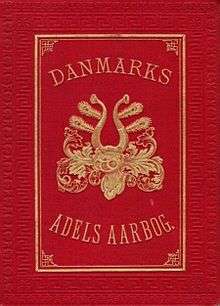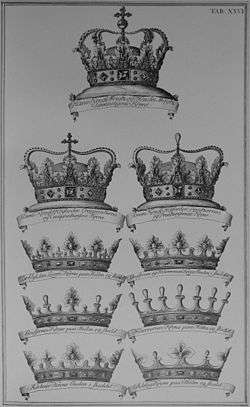Danish nobility

Danish nobility is a social class and a former estate in the Kingdom of Denmark. The nobility has official recognition in Denmark, a monarchy. Its legal privileges were abolished in the 19th century. Many of the families still own and reside in castles or country houses. Most nobles still belong to the elite, and they are as such present at royal events where they hold court posts, are guests, or are objects of media coverage, for example Kanal 4's TV-hostess Caroline Fleming née Baroness Iuel-Brockdorff. Some of them own and manage companies or have leading positions within business, banking, diplomacy and NGOs.
Danish nobility is informally divided into two categories: ancient nobility (Danish: uradel) and letter nobility (Danish: brevadel). A more recognised categorization distinguishes between high and lower nobility (Danish: højadel, lavadel). Today, approximately 200 noble houses bearing hereditary titles such as baron or count are extant. "Ancient nobility" refers to those noble houses that are known from the era before the Danish reformation, whereas created nobility are those houses that received their rank by a patent at the time of their elevation to the nobility. Families of the Lord High Councillors of Denmark, and houses endowed with a title (after the commencement of absolutism in Denmark) are regarded as high nobility of Denmark.
Medieval nobility
A striking feature has been the close ties medieval Danish magnate families had with German (Thuringian, Lower-Saxon, etc.) counts: for example in the 13th century, there are several marriages between Danish magnate families and German counts in each generation.
- Members of the families of the counts of Orlamünde, Regenstein, Gleichen and Everstein settled in Scandinavia and became, for example, High Councillors and, a few of them, Lord High Constables of Denmark.
- Various branches of the Counts of Holstein contracted marriages with members or relatives of the Danish royal dynasty, and occasionally were numbered among the highest nobles in Denmark. During the reign of Christopher II of Denmark and the early reign of Valdemar IV of Denmark, counts of Holstein held almost all fiefs in Denmark. Specifically, the Holsteins tended to ally with the Abel branch of the royal dynasty, which held the duchy of Southern Jutland, adjacent to Holstein. Ultimately, in the late 14th century, the Rendsborg branch of the House of Holstein inherited the south-Jyllander duchy (henceforward known as Duchy of Schleswig) as Danish vassals. Adolf VIII, Count of Holstein, was actually offered the Danish royal throne in 1448, and after his refusal, his nephew Christian I of Denmark received it.
- The family of Putbusch (Podebusk in Danish), originally relatives of the earliest princes of Rügen, were almost Danish in the 14th century, their most prominent member being Henning Podebusk, the powerful Lord High Justiciar of Denmark during the reigns of King Valdemar IV and the Queen Margaret of Scandinavia. After the 16th century, one branch (the Kjørup branch) of the Podebusks remained in Denmark and belonged to the country's high nobility.
Noble titles
Modern titles

Artist: Lauritz de Thurah
Introduced in 1671 with the titles of baron and count, and among others supplied with the title of marquis in 1709, the following system is currently in force.
| Title | Title for wives | Title for sons | Title for daughters | Dignity or fief | English Equivalent |
|---|---|---|---|---|---|
| hertug | hertuginde | hertugdømme | duke | ||
| markis | markise | markisat | marquis | ||
| greve | grevinde | greve or baron | komtesse | grevskab | count |
| friherre baron |
frifrue baronesse |
friherre baron |
friherrinde baronesse |
friherreskab baroni |
baron |
Note: The class of barons and the class of counts were internally divided. A count would be a titular count (greve), a feudal count (lensgreve) or a national count (rigsgreve). Likewise a baron would be titular, feudal or national.
Duke
Two families bear the Danish title of duke:
- Dukes of Schleswig (hertug af Slesvig): originally, descendants of Gerhard III, who was granted the Duchy of Jutland, which was taken back, but the title was recognized in 1386. In 1459 the title passed through a female heiress to the House of Oldenburg, descending to its branches of Augustenborg, Pløn, Beck, Glücksburg/Lyksborg, Holstein-Gottorp, Sønderborg, Nordborg, Rethwisch, Ærø, Franzhagen, Wiesenburg. Although the members possessed the title of duke in Denmark sovereignty over these lands remained for centuries in the authority of their pater familias, the king of Denmark acting as its overlord.
- Duke of Glücksbierg (hertug af Glücksbierg): 1818 primogeniture within the French ducal family of Decazes.
Dukes had earlier the German-inspired style of durchlauchtighed (German: Durchlaucht; English: Serene Highness), but Danish ducal titles are in present virtually non-existent. In historical contexts, for example, older predicates as (your) grace or højvelbårenhed are applied.
Marquis
In 1709 Frederick IV of Denmark, in his capacity as King of Norway, granted the title Marquis of Lista to Hugo Octavius Accoramboni of Florence in Italy. Apparently the Marquis of Lista died without issue.
In 1710 the same king granted the title Marquis of Mandal to Francisco di Ratta and to the latter's nephews Giuseppe di Ratta and Luigi di Ratta of Bologna in Italy. In Norway official recognition of this title was abolished under the 1821 Nobility Law. In Denmark it seems to have lasted until 1890.[1]
Norway remains the only country in Scandinavia to which the title of marquis has been attached.
Noble families
There are two primary periodical reviews of Danish nobility:
- Danmarks Adels Aarbog (DAA), published by Dansk Adels Forening since 1884. It publishes genealogies of extant Danish noble families, approximately 725. Additionally, ancestry charts published in its editions, have reported approximately 200 extinct houses.[2]
- Dansk Adelskalender
| List |
|---|
|
A B
C
D
E
F
G
H
J
K L
M–N
O–S and Ø
P
R
S
T–U
V–Z
|
See also
References
- ↑ Store norske leksikon: Mandal – adelstittel
- ↑ Index Danmarks Adels Aarbog: http://www.genealogi.no/kilder/DAA/DAA-reg.htm
